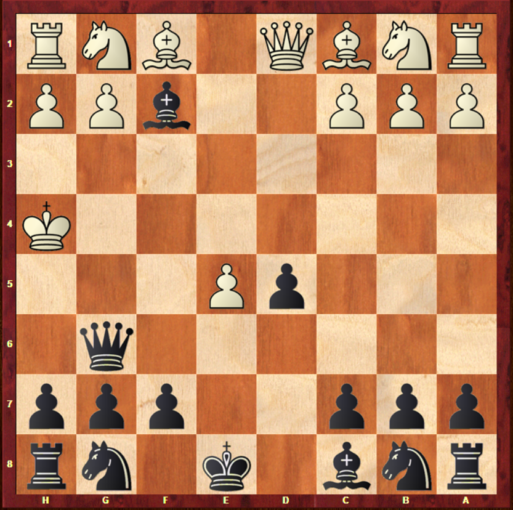
Falkbeer Countergambit
You’ve already seen that the King’s Gambit is a powerful weapon. If Black isn’t ready to respond properly in the opening, they will easily lose the game in a few moves.
It’s clear as day that simply accepting the opponent’s sacrificed pawn is the wrong strategy. Why? It forces you to go on the defensive in the struggle for extra material. But if you try a different approach and drastically disdain the gift, you’ll seize the initiative!
The best defense is a good offense! This proverb perfectly describes the Falkbeer Countergambit. If used properly, it will be more than effective in the fight against the King’s Gambit.
Ernst Falkbeer was a chess player and theorist who lived in the 19th century. He had a powerful mind, which is proved by one of his games. Falkbeer had a draw match (8.5-8.5) against Henry Bird, one of the strongest players in England at the time.
Logical-Based Development
So, our variation can be launched after the following moves: 1. e4-e5; 2. f4-d5! We don’t attack the pawn. Instead, we start fighting for the center right away!

If White responds with 3. Fxe5??, they will definitely lose the game. Just send your queen to h4 (3. Qh4) to make any further opponent’s moves fruitless. The victory will be yours. Read below to see how it works!

Let’s imagine that the match proceeds like this: 4. g3-Qxe4. It’s a double strike against the king and rook. After White covers their monarch (e.g., 5. Qe2-Qxh1), Black takes the rook. If you follow this scenario, White will have nothing to do but give up by the sixth move. Isn’t it beautiful?

But let’s go one move back: 4. Ke2-Qxe4. This variant forces White to get a checkmate!

5. Kf2 – Bc5+. The queen can’t win the match alone. With the tempo, the dark-colored bishop joints the attack.

6. d4-Bxd4. A white pawn tries to stop our bishop but it simply can’t!
Completing the Falkbeer Countergambit

7. Kg3-Qg6+. Have you noticed that we attack the white king with each new move? Our opponent doesn’t have time to take a breath!

8. Kh4-Bf2+. We use different pieces to threaten the opposing monarch. Can you smell the victory already?

9. g3-Qe4+. Don’t give the opponent even a chance to relax, it’s the key! Blow another check instead. 2-3 additional moves and the match is over!

10. Bf4-Qxf4+. It’s an important move. You may think that a white pawn can eat our queen. But it’s an illegal move. Our f2-bishop is tied to the opponent’s king. If the g3-pawn leaves its square, it creates a threat to the monarch. As we know, the rules forbid this piece to be under a strike.

11. Kh5 – g6#. It’s an impressive way to end the match. The pawn checkmates the king!

Falkbeer Countergambit – More Challenging Development
Now let’s imagine that White chooses a different path. It’ll make the chances for victory equal for both sides.
3. exd5-exf4. Both players go for the exchange of pawns. As a result, many fields near the white monarch are weakened. It’s good for Black.

4. Nf3. There is no need to protect the white pawn. All because the gambit variant is all about the fast development of pieces in the first place. With subsequent attacks on the king. 4. Nf6. Black also focuses on deploying light pieces.

5. Bb5+. It’s one of the basic options to choose in this match (along with Bc4). White deploys the bishop with tempo. 5. c6. Black dodges the check, attacking the bishop at the same time.

6. dxc6-Nxc6; 7. d4 – Bd6. White occupies the center, attempting to eat your f4-pawn. This is why we back it up with the bishop.
It’s crucial that after 8. d5, we can answer with Nxd5!!. And after 9. Qxd5, we go with Bb4 with the further capture of the queen.

But let’s go one move back. 8. 0-0 – 0-0. Both sides choose to castle, ensuring protection for their kings.
9. Nd2-Bg4. White and Black make logical moves by deploying light pieces. Black also makes a beneficial tie.

10. с3 – Re8. White builds a short pawn chain, supporting a potentially weak d4-pawn. Black, in return, sends their rook to the only empty file.

From the computer point of view, Black has an advantage. We brought all the pieces into play. And most importantly, the f4-pawn controls the field e3. Our goal is to bring the knight to e3. White has lots of weak squares to deal with. All of this gives Black a great chance of success. The main thing is that we have completely neutralized the King’s Gambit. Our opponent can’t even think of attacking because they have other priorities. That is to deal with various challenges we’ve created.
We hope that today’s insight about the opening was useful for you. From now on, the King’s Gambit will not cause fear but invoke joy from a possible quick victory. After all, now you have the most powerful weapon in your arsenal – the Falkbeer Countergambit.


Hi there! I just wish to give an enormous thumbs up for the great data you might have right here on this post. I shall be coming again to your blog for more soon.